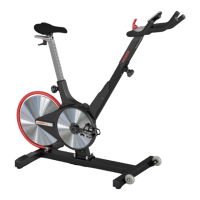-34-
POWER TRAINING ZONES
Once the power test is complete, the data obtained is used to determine an individual’s different power
zones and levels. Using Watts, riders can move from one zone to another using the specific physiological
adaptations appropriate to the features of each level. The idea of training within Watts zones is similar
to the idea of training within heart-rate zones.
TRAINING ZONES DEFINED
ZONE
EFFORT
TYPE
RATING OF
PERCEIVED
EXERTION (RPE)
HEART RATE
MAX %
HEART RATE
THRESHOLD
(FTHR) %
POWER
THRESHOLD
(FTP) %
HOW DOES
IT FEEL?
1
Active
Recovery
<2 50–60 <69 <55
• Easy
• Light pedal pressure
• Minimal sensation of leg effort/fatigue
• Used for active recovery after strenuous training day
2
Endurance 3–4 60–70 69–83 55–75
• All-day pace or long slow endurance training
• Sensation of leg effort/fatigue generally low
• Breathing is more regular than at level 1
3
Tempo 5–6 70–80 84–94 76–90
• More frequent/greater sensation of leg effort/fatigue
than at level 2
• Requires concentration to maintain, especially at
upper end of range
• Breathing deeper and more rhythmic than level 2, such
that any conversation must be somewhat halting but not
as difficult as at level 4
4
Lactate
Threshold
7–8 80–90 95–105 91–105
• Just belo
w to just above Lactate Threshold
•
Continuous sensation of moderate or even greater leg
effort/fatigue
• Continuous conversation difficult at best
• Effort sufficiently high that sustained exercise at this level
is mentally very taxing
• Consecutive days of training at level 4 possible, but such
workouts generally only performed when sufficiently
rested/recovered
5a
VO2 Max 8–9 90–95 106 106–120
• Typical intensity of longer (3–8 min) intervals intended to
increase VO2 max
• Strong to severe sensations of leg effort/fatigue, such
that completion of more than 30–40 min total training
time is difficult at best
• Should generally be attempted only when adequately
recovered from prior training — consecutive days of level
5 work not necessarily desirable even if possible
• At this level, the average heart rate may not be relevant
due to slowness of heart rate response and/or ceiling
imposed by maximum heart rate
5b
Anaerobic
Capacity
10 95–100 N/A 121–150
• Short (30 sec to 3 min), high-intensity intervals designed
to increase anaerobic capacity
• Heart rate not useful as guide to intensity due to
non-steady-state nature of effort
• Severe sensation of leg effort/fatigue and
conversation impossible
5c
Neuro
Muscular
Max 100 N/A >150
• Very short, very high-intensity efforts (e.g., short sprints)
that generally place greater stress on
musculoskeletal rather than metabolic systems
PHYSIOLOGY

